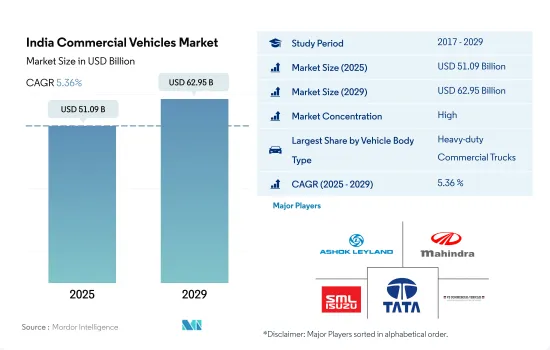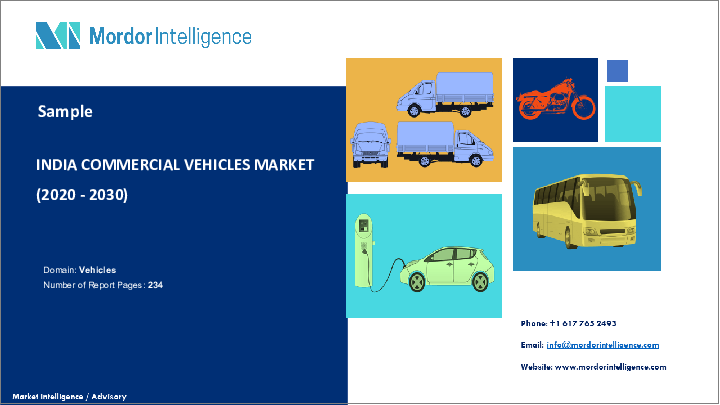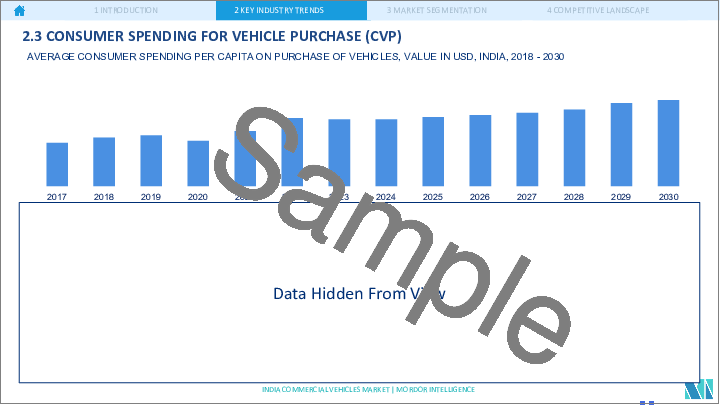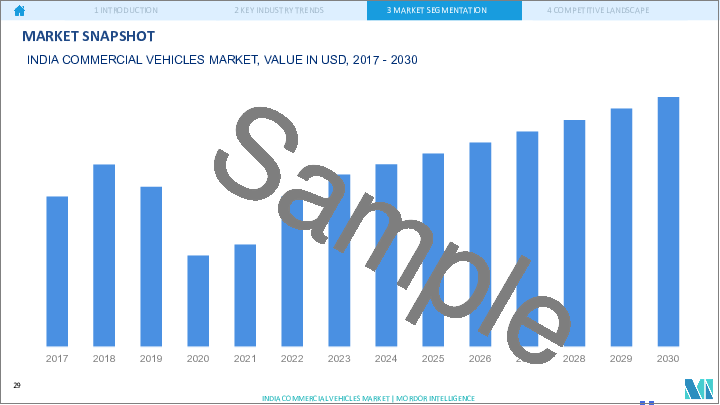|
|
市場調査レポート
商品コード
1693643
インドの商用車市場:市場シェア分析、産業動向・統計、成長予測(2025~2030年)India Commercial Vehicles - Market Share Analysis, Industry Trends & Statistics, Growth Forecasts (2025 - 2030) |
||||||
カスタマイズ可能
適宜更新あり
|
|||||||
| インドの商用車市場:市場シェア分析、産業動向・統計、成長予測(2025~2030年) |
|
出版日: 2025年03月18日
発行: Mordor Intelligence
ページ情報: 英文 234 Pages
納期: 2~3営業日
|
全表示
- 概要
- 目次
インドの商用車市場規模は2025年に510億9,000万米ドルと推定・予測され、2029年には629億5,000万米ドルに達し、予測期間(2025-2029年)のCAGRは5.36%で成長すると予測されます。

インドの多様な商業輸送ニーズに応えるため、車両設計の効率性と適応性を重視した多用途なアプローチを示す
- インドの商用車市場には、小型商用車(LCV)、中型トラック(MDT)、大型トラック(HDT)、バスなど、さまざまな車体タイプが含まれます。この市場は、インドの経済情勢において極めて重要な役割を担っており、広大な国土における物資や旅客の移動を促進しています。各車両セグメントの市場動向は、インドの経済、インフラ、規制におけるより広範な変化を反映しており、輸送・ロジスティクス部門に関する貴重な洞察を提供しています。
- LCVは、その適応性、費用対効果、インドの多様でしばしば困難な道路状況をナビゲートする能力により、インドの商用車市場を独占しています。これらの車両は、都市部と農村部の両方の物流、特に遠隔地へのアクセスが最重要となるeコマース、宅配便、FMCG流通などの分野で、基幹的な役割を果たしています。このセグメントの成長は、GST税率の引き下げや、輸送をLCVに大きく依存しているMSMEセクターを支援する取り組みなど、政府の好意的な政策によって後押しされています。
- MDTとHDTは長距離輸送に不可欠で、インドの拡大するインフラと産業部門で重要な役割を果たしています。これらの車両は、建設、鉱業、重量物輸送で主に使用され、大容量と耐久性が不可欠です。MDTとHDTの需要は、経済成長、インフラ・プロジェクト、工業生産高と密接に結びついています。BS-VI排ガス規制の採用など最近の規制改正は、このセグメントの技術進歩に拍車をかけたが、車両コストの上昇にもつながり、需要動態に影響を与えています。
インドの商用車市場の動向
政府のイニシアティブと厳しい規範がインドの電気自動車市場の急成長を牽引
- インドの電気自動車(EV)市場は成長段階にあり、政府が公害対策戦略を積極的に策定しています。2015年に開始されたFame Indiaスキームは、自動車の電動化を推進する上で極めて重要な役割を果たしました。その成功を受けて、2022年4月まで実施されるフェイム・フェーズ2は、特に2021年のEV販売をさらに強化し、政府はバッテリー容量が15kWhまでの電気自動車に1万インドルピー(約1,000万円)の補助金を提供しています。
- インド全土の州政府は、内燃機関(ICE)バスからの移行を目指し、電気バスを導入するケースが増えています。この動きは、運行コストを削減するだけでなく、二酸化炭素排出を抑制し、大気の質を改善します。注目すべき動きとして、デリー政府は2021年3月に300台の新型低床電気(AC)バスの調達を許可し、そのうち100台は2022年1月に道路に投入されました。こうした取り組みにより、2022年のインドにおける電気商用車の需要は2021年比で62.58%と大幅に急増しました。
- 電気自動車の需要は、政府の厳しい基準導入に後押しされ、ここ最近急増しています。2021年8月、インド政府は車両スクラップ政策を発表し、年式に関係なく汚染車両や不適合車両を段階的に廃止することを目標としました。この政策は2024年までに実施されることになっており、消費者を電気自動車に誘導しています。さらに政府は、2030年までにインドの全自動車の30%を電動化するという野心的な目標を掲げています。こうした取り組みにより、インドでは2024年から2030年にかけて電気自動車の販売が促進される見込みです。
インドの商用車産業の概要
インドの商用車市場はかなり統合されており、上位5社で91.28%を占めています。この市場の主要企業は以下の通り。 Ashok Leyland Limited, Mahindra & Mahindra Limited, SML Isuzu Limited, Tata Motors Limited and VE Commercial Vehicles Limited(アルファベット順)
その他の特典
- エクセル形式の市場予測(ME)シート
- 3ヶ月のアナリストサポート
目次
第1章 エグゼクティブサマリーと主な調査結果
第2章 レポートのオファー
第3章 イントロダクション
- 調査の前提条件と市場定義
- 調査範囲
- 調査手法
第4章 主要産業動向
- 人口
- 一人当たりGDP
- 自動車購入のための消費者支出(cvp)
- インフレ率
- 自動車ローン金利
- 電化の影響
- EV充電ステーション
- バッテリーパック価格
- Xev新モデル発表
- 物流性能指数
- 燃料価格
- OEM生産統計
- 規制の枠組み
- バリューチェーンと流通チャネル分析
第5章 市場セグメンテーション
- 車体タイプ
- バス
- 大型商用トラック
- 小型商用ピックアップトラック
- 小型商用バン
- 推進タイプ
- ハイブリッド車および電気自動車
- BEV
- FCEV
- HEV
- PHEV
- ICE
- 天然ガス
- ディーゼル
- ガソリン
- LPG
- ハイブリッド車および電気自動車
第6章 競合情勢
- 主要な戦略動向
- 市場シェア分析
- 企業情勢
- 企業プロファイル
- Ashok Leyland Limited
- Asia Motor Works Limited
- Daimler India Commercial Vehicles Pvt. Ltd.
- Eicher Motors Ltd.
- Force Motors Ltd.
- Mahindra & Mahindra Limited
- SML Isuzu Limited
- Tata Motors Limited
- VE Commercial Vehicles Limited
- Volvo Buses India Private Limited
第7章 CEOへの主な戦略的質問
第8章 付録
- 世界概要
- 概要
- ファイブフォース分析フレームワーク
- 世界のバリューチェーン分析
- 市場力学(DROs)
- 情報源と参考文献
- 図表一覧
- 主要洞察
- データパック
- 用語集
The India Commercial Vehicles Market size is estimated at 51.09 billion USD in 2025, and is expected to reach 62.95 billion USD by 2029, growing at a CAGR of 5.36% during the forecast period (2025-2029).

Indicates a versatile approach to meet the country's diverse commercial transport needs, emphasizing efficiency and adaptability in vehicle design
- The Indian commercial vehicles market encompasses various vehicle body types, including light commercial vehicles (LCVs), medium-duty trucks (MDTs), heavy-duty trucks (HDTs), and buses. This market plays a pivotal role in India's economic landscape, facilitating the movement of goods and passengers across the country's vast geography. The market trends in each vehicle segment mirror broader shifts in India's economy, infrastructure, and regulations, offering valuable insights into the transportation and logistics sectors.
- LCVs dominate the Indian commercial vehicles market thanks to their adaptability, cost-effectiveness, and ability to navigate the country's diverse and often challenging road conditions. These vehicles serve as the backbone of both urban and rural logistics, particularly in sectors like e-commerce, courier services, and FMCG distribution, where their accessibility to remote areas is paramount. The segment's growth is bolstered by favorable government policies, including reduced GST rates and initiatives supporting the MSME sector, which heavily relies on LCVs for transportation.
- MDTs and HDTs are vital for long-haul transportation, playing a key role in India's expanding infrastructure and industrial sectors. These vehicles find primary use in construction, mining, and heavy goods transportation, where their larger capacity and durability are essential. The demand for MDTs and HDTs closely aligns with economic growth, infrastructure projects, and industrial output. Recent regulatory changes, such as the adoption of BS-VI emission standards, have spurred technological advancements in this segment but have also led to increased vehicle costs, impacting demand dynamics.
India Commercial Vehicles Market Trends
Government initiatives and stringent norms drive rapid growth in the electric vehicle market in India
- India's electric vehicle (EV) market is in a growth phase, with the government actively formulating strategies to combat pollution. The Fame India scheme, launched in 2015, has played a pivotal role in driving vehicle electrification. Building on its success, Fame Phase 2, active till April 2022, further bolstered EV sales, especially in 2021, with the government offering subsidies like INR 10,000 grants for electric cars with battery capacities up to 15 kWh.
- State governments across India are increasingly incorporating electric buses into their fleets, aiming to transition from internal combustion engine (ICE) buses. This move not only cuts operational costs but also curbs carbon emissions and improves air quality. In a notable move, the Delhi government greenlit the procurement of 300 new low-floor electric (AC) buses in March 2021, with 100 of them hitting the roads in January 2022. These initiatives contributed to a significant 62.58% surge in demand for electric commercial vehicles in India in 2022 over 2021.
- The demand for electric cars has surged in recent times, driven by the government's introduction of stringent norms. In August 2021, the Indian government unveiled the Vehicle Scrappage Policy, targeting the phasing out of polluting and unfit vehicles, irrespective of their age. This policy, set to be implemented by 2024, is steering consumers toward electric cars. Additionally, the government has set an ambitious target of having 30% of all cars in India electrified by 2030. These initiatives are poised to propel electric car sales during the 2024-2030 period in India.
India Commercial Vehicles Industry Overview
The India Commercial Vehicles Market is fairly consolidated, with the top five companies occupying 91.28%. The major players in this market are Ashok Leyland Limited, Mahindra & Mahindra Limited, SML Isuzu Limited, Tata Motors Limited and VE Commercial Vehicles Limited (sorted alphabetically).
Additional Benefits:
- The market estimate (ME) sheet in Excel format
- 3 months of analyst support
TABLE OF CONTENTS
1 EXECUTIVE SUMMARY & KEY FINDINGS
2 REPORT OFFERS
3 INTRODUCTION
- 3.1 Study Assumptions & Market Definition
- 3.2 Scope of the Study
- 3.3 Research Methodology
4 KEY INDUSTRY TRENDS
- 4.1 Population
- 4.2 GDP Per Capita
- 4.3 Consumer Spending For Vehicle Purchase (cvp)
- 4.4 Inflation
- 4.5 Interest Rate For Auto Loans
- 4.6 Impact Of Electrification
- 4.7 EV Charging Station
- 4.8 Battery Pack Price
- 4.9 New Xev Models Announced
- 4.10 Logistics Performance Index
- 4.11 Fuel Price
- 4.12 Oem-wise Production Statistics
- 4.13 Regulatory Framework
- 4.14 Value Chain & Distribution Channel Analysis
5 MARKET SEGMENTATION (includes market size in Value in USD and Volume, Forecasts up to 2029 and analysis of growth prospects)
- 5.1 Vehicle Body Type
- 5.1.1 Buses
- 5.1.2 Heavy-duty Commercial Trucks
- 5.1.3 Light Commercial Pick-up Trucks
- 5.1.4 Light Commercial Vans
- 5.2 Propulsion Type
- 5.2.1 Hybrid and Electric Vehicles
- 5.2.1.1 By Fuel Category
- 5.2.1.1.1 BEV
- 5.2.1.1.2 FCEV
- 5.2.1.1.3 HEV
- 5.2.1.1.4 PHEV
- 5.2.2 ICE
- 5.2.2.1 By Fuel Category
- 5.2.2.1.1 CNG
- 5.2.2.1.2 Diesel
- 5.2.2.1.3 Gasoline
- 5.2.2.1.4 LPG
- 5.2.1 Hybrid and Electric Vehicles
6 COMPETITIVE LANDSCAPE
- 6.1 Key Strategic Moves
- 6.2 Market Share Analysis
- 6.3 Company Landscape
- 6.4 Company Profiles
- 6.4.1 Ashok Leyland Limited
- 6.4.2 Asia Motor Works Limited
- 6.4.3 Daimler India Commercial Vehicles Pvt. Ltd.
- 6.4.4 Eicher Motors Ltd.
- 6.4.5 Force Motors Ltd.
- 6.4.6 Mahindra & Mahindra Limited
- 6.4.7 SML Isuzu Limited
- 6.4.8 Tata Motors Limited
- 6.4.9 VE Commercial Vehicles Limited
- 6.4.10 Volvo Buses India Private Limited
7 KEY STRATEGIC QUESTIONS FOR VEHICLES CEOS
8 APPENDIX
- 8.1 Global Overview
- 8.1.1 Overview
- 8.1.2 Porter's Five Forces Framework
- 8.1.3 Global Value Chain Analysis
- 8.1.4 Market Dynamics (DROs)
- 8.2 Sources & References
- 8.3 List of Tables & Figures
- 8.4 Primary Insights
- 8.5 Data Pack
- 8.6 Glossary of Terms





